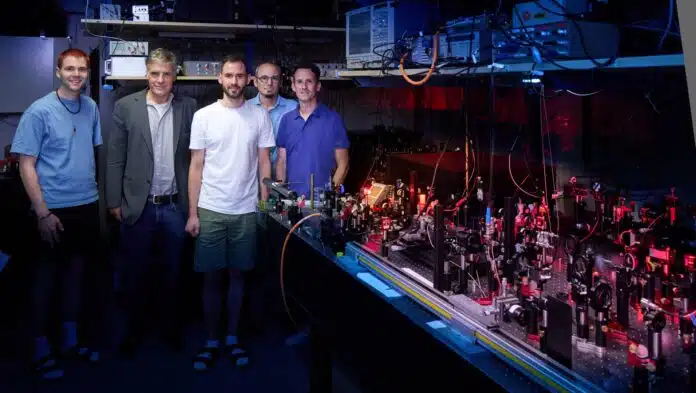
By Pranjal Malewar 7 Oct, 2024
Collected at: https://www.techexplorist.com/scientists-created-imprint-super-photon/90797/
When several light particles are cooled and confined into compact space, they become identical and act as a single super photon. Physicists dubbed this phenomenon Bose-Einstein condensate, and it normally resembles a blurry speck of light.
The researchers at the IAP have imprinted a simple lattice structure on the condensate. They created super photons by filling a tiny container with a dye solution.The video player is currently playing an ad.
In a reflective container, dye molecules are excited by a laser, generating photons that bounce between the walls. Initially warm, these photons lose energy through collisions with the dye molecules, eventually cooling down and condensing into a super photon.
Andreas Redmann from the Institute of Applied Physics (IAP) at the University of Bonn said, “The reflective surfaces are normally perfectly smooth. We deliberately added small indents to them, figuratively providing more space for the light to collect. This effectively imprints a structure onto the condensate – almost like when you press a mold with one closed side downwards into a sandbox: If you lift it up again, you can still see the imprint of the mold in the sand.”

“In this way, we have created four regions where the condensate prefers to stay. It is as if you were to divide a bowl of water between four cups arranged in quadratic form. In contrast to water, however, the super photon will not necessarily split into four smaller portions. If the cups are positioned together closely enough so the light particles can pass quantum mechanically back and forth between them, it remains as one condensation.”
This property can enable quantum entanglement, where a change in light from one cup affects the light in others, facilitating secure communication among multiple participants. Redmann notes that modifying the reflective surfaces makes it possible to create Bose-Einstein condensates spread across many lattice sites, enhancing tap-proof communication. Their study demonstrates how to deliberately create specific emission patterns for various technological applications, making this method highly promising.
Journal Reference:
- Andreas Redmann, Christian Kurtscheid, Niels Wolf, Frank Vewinger, Julian Schmitt and Martin Weitz: Bose-Einstein Condensation of Photons in a Four-Site Quantum Ring; Physical Review Letters; Andreas Redmann, Christian Kurtscheid, Niels Wolf, Frank Vewinger, Julian Schmitt and Martin Weitz: Bose-Einstein Condensation of Photons in a Four-Site Quantum Ring; Physical Review Letters; DOI: 10.1103/PhysRevLett.133.09360

Leave a Reply